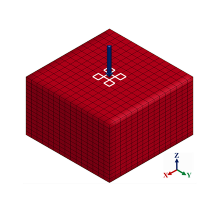Owing to the physical and chemical complexity of the thermokinetic coating processes aside the extraordinary efforts involved in their online diagnostics, modeling and numerical simulations in the field of modern surface technology is becoming increasingly important. The accompanied objectives include not only gaining deeper insight into the process itself but also enabling predicting the different obtained coating properties. Such a property, which plays a decisive role for the functional integrity and efficiency of deposited surface coatings, is the obtained residual stresses profiles of the substrate-coating composite. In that sense, it is crucial that the residual stresses do not exceed critical values, which could lead to coating delamination, neither during the manufacturing process nor while being deployed in-service. Accordingly, the development and validation of a reliable approach for the computational simulation and prediction of residual stresses development in thermally sprayed coatings is of high significance.
The implemented strategy involve addressing the process of coating buildup and the accompanied residual stresses development on a macroscale through applying a comprehensive approach in the field of thermal spray technology. Different modeling principles are separately implemented to allow simulating the entire chain of residual stresses generation during the coating buildup process. The result is layered structural model, which enables the time and location-based visualization and quantification of temperature distribution and the internal stresses development, depending on the given robot trajectories, utilized coating parameters and taking into consideration the coating and substrate materials used.

Publications
P 872: Elhoriny, M.; Wenzelburger, M.; Killinger, A.; Gadow, R.: Finite Element Simulation of Residual Stress Development in Thermally Sprayed Coatings. In: Journal of Thermal Spray Technology, pp. 1–10. DOI: 10.1007/s11666-017-0538-5 P 872: Elhoriny, M.; Wenzelburger, M.; Killinger, A.; Gadow, R.: Finite Element Simulation of Residual Stress Development in Thermally Sprayed Coatings. In: Journal of Thermal Spray Technology, pp. 1–10. DOI: 10.1007/s11666-017-0538-5


